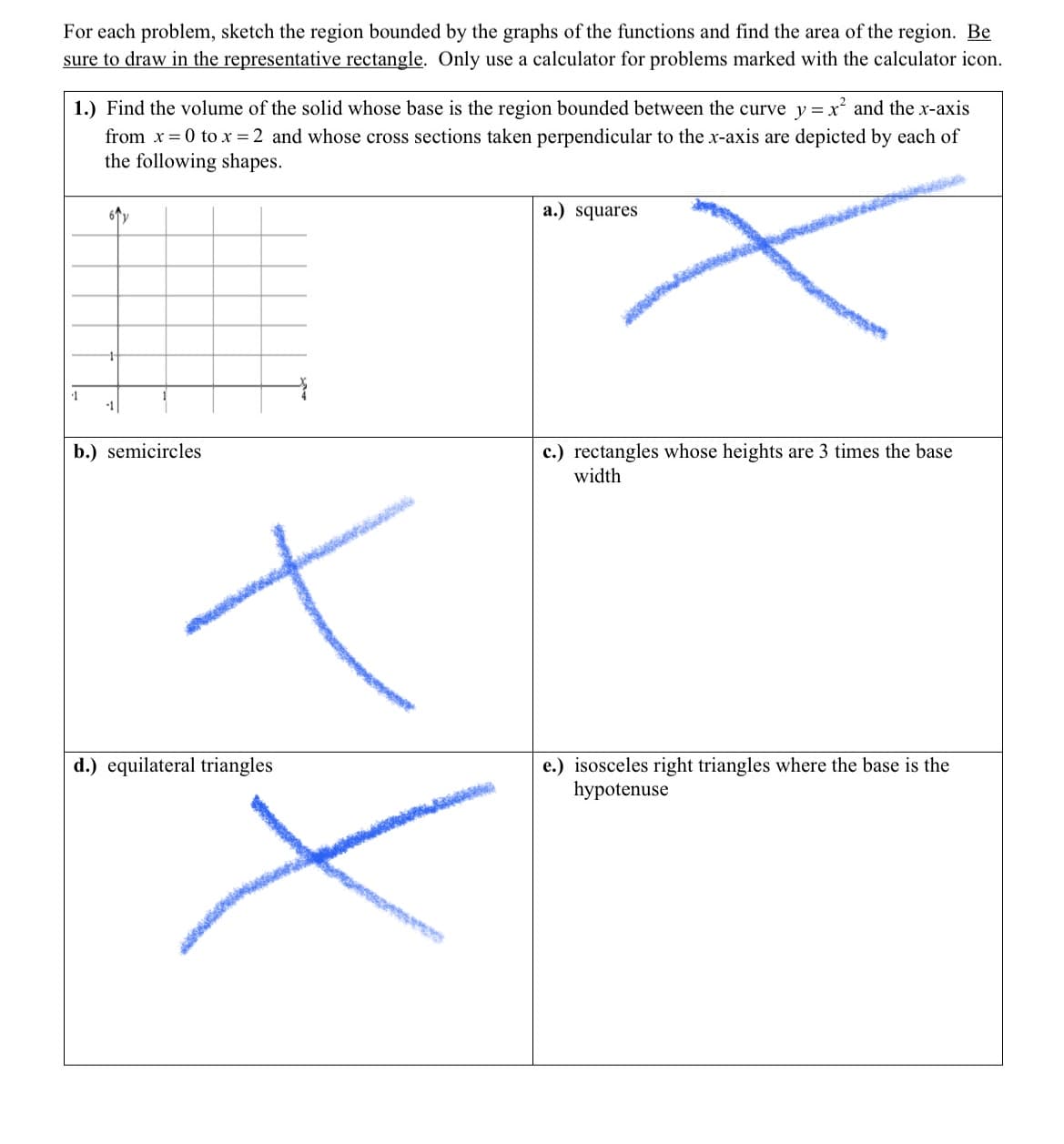For each problem, sketch the region bounded by the graphs of the functions and find the area of the region. Be sure to draw in the representative rectangle. Only use a calculator for problems marked with the calculator icon. 1.) Find the volume of the solid whose base is the region bounded between the curve y = x² and the x-axis from x = 0 to x = 2 and whose cross sections taken perpendicular to the x-axis are depicted by each of the following shapes. 1 -1 b.) semicircles t d.) equilateral triangles a.) squares c.) rectangles whose heights are 3 times the base width e.) isosceles right triangles where the base is the hypotenuse
For each problem, sketch the region bounded by the graphs of the functions and find the area of the region. Be sure to draw in the representative rectangle. Only use a calculator for problems marked with the calculator icon. 1.) Find the volume of the solid whose base is the region bounded between the curve y = x² and the x-axis from x = 0 to x = 2 and whose cross sections taken perpendicular to the x-axis are depicted by each of the following shapes. 1 -1 b.) semicircles t d.) equilateral triangles a.) squares c.) rectangles whose heights are 3 times the base width e.) isosceles right triangles where the base is the hypotenuse
Functions and Change: A Modeling Approach to College Algebra (MindTap Course List)
6th Edition
ISBN:9781337111348
Author:Bruce Crauder, Benny Evans, Alan Noell
Publisher:Bruce Crauder, Benny Evans, Alan Noell
ChapterA: Appendix
SectionA.2: Geometric Constructions
Problem 10P: A soda can has a volume of 25 cubic inches. Let x denote its radius and h its height, both in...
Related questions
Question
C and E only

Transcribed Image Text:For each problem, sketch the region bounded by the graphs of the functions and find the area of the region. Be
sure to draw in the representative rectangle. Only use a calculator for problems marked with the calculator icon.
1.) Find the volume of the solid whose base is the region bounded between the curve y = x² and the x-axis
from x = 0 to x = 2 and whose cross sections taken perpendicular to the x-axis are depicted by each of
the following shapes.
1
-1
b.) semicircles
t
d.) equilateral triangles
a.) squares
c.) rectangles whose heights are 3 times the base
width
e.) isosceles right triangles where the base is the
hypotenuse
Expert Solution
This question has been solved!
Explore an expertly crafted, step-by-step solution for a thorough understanding of key concepts.
This is a popular solution!
Trending now
This is a popular solution!
Step by step
Solved in 2 steps with 2 images

Recommended textbooks for you

Functions and Change: A Modeling Approach to Coll…
Algebra
ISBN:
9781337111348
Author:
Bruce Crauder, Benny Evans, Alan Noell
Publisher:
Cengage Learning

Elementary Geometry For College Students, 7e
Geometry
ISBN:
9781337614085
Author:
Alexander, Daniel C.; Koeberlein, Geralyn M.
Publisher:
Cengage,

Functions and Change: A Modeling Approach to Coll…
Algebra
ISBN:
9781337111348
Author:
Bruce Crauder, Benny Evans, Alan Noell
Publisher:
Cengage Learning

Elementary Geometry For College Students, 7e
Geometry
ISBN:
9781337614085
Author:
Alexander, Daniel C.; Koeberlein, Geralyn M.
Publisher:
Cengage,